Contributed Commentary by Virginia Klausmeier, CEO, Sylvatex Inc
February 13, 2025 | In today’s shifting geopolitical and economic landscape, the United States stands at a pivotal crossroads. The global push for a green economy and the rapid adoption of electric vehicles (EVs) have created an unprecedented demand for critical battery materials. Yet, as a nation, we remain heavily reliant on imported materials like lithium and cobalt—a dependency that exposes us to significant supply chain risks and limits our energy independence. The time to act is now. By scaling domestic production, we can solidify America’s leadership in the green economy while creating jobs, reducing emissions, and fostering innovation.
Strategic Importance
The global battery supply chain—from raw materials to refining, production, and recycling—is heavily concentrated in China, creating significant vulnerabilities for U.S. manufacturers. This dominance extends beyond lithium and cobalt to include critical processing infrastructure and component manufacturing, leaving the entire value chain exposed to geopolitical disruptions. For example, while over 70% of the world’s cobalt originates in the Democratic Republic of Congo—raising ethical and environmental concerns—China controls much of the refining capacity needed to turn raw materials into battery-grade products.
Investing in a robust domestic supply chain isn’t just about securing raw materials—it’s about building capacity across the full value chain, from extraction to advanced material processing and battery assembly. Strengthening these capabilities will reduce our dependence on foreign suppliers, safeguard national security, and ensure the U.S. remains competitive in markets that will shape the electrification of everything—an unprecedented industrial revolution that will transform the future of transportation and energy storage. China has spent years cementing its leadership position in this space. Now is the time for the U.S. to surpass the current status quo, harnessing its industrial innovation capabilities to reshape the future and lead the charge forward.
Economic and Environmental Impact
A domestic supply chain isn’t just a matter of national security—it’s an economic and environmental imperative. Building this infrastructure at home means creating well-paying jobs across the country, from mining and processing to manufacturing and distribution. These are jobs that can revitalize communities and support a new generation of American workers.
By localizing the supply chain, we can cut emissions and embrace advanced environmental standards. And, innovative advancements like waterless cathode production for batteries eliminate a significant source of water and chemical waste, creating a cleaner and more efficient process. When paired with battery recycling—where used batteries are repurposed into raw materials—the entire lifecycle becomes far more sustainable. U.S. companies are already making strides in this area, showcasing the potential of a circular economy.
Legislative Leverage
The Inflation Reduction Act (IRA) and the Bipartisan Infrastructure Law (BIL) offer historic opportunities to accelerate the transition to a domestic supply chain. These policies include incentives for EV adoption, subsidies for clean energy technologies, and funding for infrastructure projects—all of which can help bridge the gap from concept to large-scale production.
However, to maximize the impact of these legislative tools, we need coordinated action between policymakers, industry leaders, and local communities. This means not only securing funding but also streamlining permitting processes, encouraging workforce development, and fostering innovation. Federal and state governments can play a critical role in reducing red tape, incenting demand, and ensuring that these programs deliver on their promise.
Innovation and Collaboration
Meeting the growing demand for EVs and grid storage will require groundbreaking innovations, and these won’t come from a single entity. Public-private partnerships are key to driving technological advancements and scaling production. For example, collaborations between universities, startups, and established manufacturers can accelerate the journey from lab breakthroughs to commercial viability.
Consumer incentives also play a vital role. By making EVs more affordable and accessible, we can drive demand and create a virtuous cycle of innovation and investment. I’ve seen firsthand how collaborative approaches—involving material scientists, engineers, and financiers—can lead to scalable solutions that benefit the entire industry.
Full-Capital Stack for Feasibility
Scaling a domestic battery supply chain isn’t just a technological challenge—it’s a financial one. Traditional venture capital funding often focuses on early-stage innovation, but the journey from pilot projects to full-scale production requires a diverse range of financial support. This is where tools like loan guarantees, tax credits, and infrastructure grants become essential.
The concept of a full-capital stack—combining public and private funding sources—is crucial for bridging the funding gap. For example, federal loan programs can de-risk investments, making it easier for private capital to flow into large-scale projects. State and local governments can also contribute by offering targeted incentives and fostering industry clusters that drive regional economic growth.
A Call to Action
The transition to a robust domestic battery material supply chain is not just a dream—it’s a necessity. It’s a pathway to energy independence, economic revitalization, and environmental sustainability. But achieving this vision will require bold action, innovation and unprecedented collaboration.
As Americans, we’ve always risen to the challenge of building what the future demands. Now, we have the opportunity to lead once again. Let’s harness our ingenuity, leverage our legislative tools, and invest in the partnerships and innovations that will power the next generation. The stakes are high, but the rewards are higher. Together, we can build a cleaner, more secure, and more prosperous future.
Virginia Klausmeier is the President and CEO of Sylvatex, Inc., a venture-backed climate tech company she founded in 2012. With a robust background in chemistry and engineering, Virginia has spent over 15 years leading technical and business teams to drive innovation in sustainable technologies. She actively collaborates with national laboratories, reviews scientific awards and grants, and advises climate tech and minority-led organizations. In 2024, Virginia was honored as the first-ever Fastmarkets Voltas Awards Industry Woman of the Year. She is a fellow of All Raise and Unreasonable Group, a Technology Pioneer with the World Economic Forum, and a member of the Alliance of CEOs, Astia, and E2. Virginia earned her B.S. in Chemistry and Economics and M.S. in Engineering from the University of Oregon, along with completing the Executive Program at Singularity University. She can be reached at vklausmeier@sylvatex.com.







